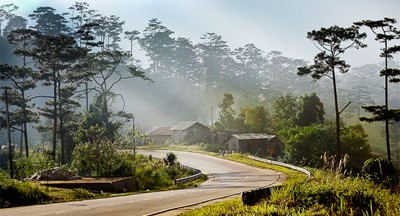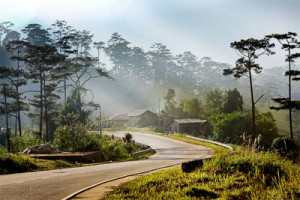Most popular for its Thien Thai Waterfalls, Bidoup-Nui Ba National Park is also frequented by tourists and scientists alike because of its abundant flora and fauna and interesting play of nature all in all.
Bidoup-Nui Ba National Park is home to many and varied plants and animals in its vast 64,000 hectares of land. Among the flora that can be found at the park are: 96 ancient plants, almost 300 species of orchids, coniferous trees, bamboo groves, pine forests, grasslands and evergreen trees. Black bears, yellow-cheeked gibbons and vampire flying frogs are just some of the fauna that are preserved in the park. The latter were discovered in 2010, while the yellow-cheeked gibbons can best be spotted early in the morning. The park is located between Lang Biang and Bidoup mountain ranges and interestingly situated above sea level between 650-2,288 meters.
Thien Thai Waterfalls of which the national park is most famous for can be found at Da Nhim Commune, Lac Duong District, 35 kilometers from Da Lat City. Travellers should take Road 723 in order to reach the site. Its average temperature is between 16-18 Degree Celsius. The waterfall is so stunning that people call it the “Abode of the God of Water” and “Country of the Immortals.”
Aside from its spectacular sight, Bidoup-Nui Ba National Park also revolves around a local legend. Based on the story, there was a pregnant woman belonging to the K’ho tribe who went to the forest supposedly to pick up fruits. But while she was there, she suddenly went into labor and thinking quickly, or simply for lack of other choices, she collected and formed the leaves on the ground into a bed and laid down on it to deliver her baby. She went back to her village with her child wrapped in the same leaves and when her neighbors saw her with a newborn baby in hand, they were all elated with the pleasant surprise. The village leader, recognizing the mother’s strength and wit, entitled the leaves “crieu” because of its significant role in the big event. All babies born after that were named the same.
Tourists visiting the park can also go trail trekking with guides belonging to different tribal groups. This gives them a chance to associate with the local culture while immersing in nature at the same time. A camp fire and gong dance is conducted at night, with K’ho girls performing dressed in brocade. Visitors are required to take a sip of the traditional wine ruou can which is drunk from a jar using long bamboo straws.
Asian and Western food is served, but any trip would not be complete without tasting the local cuisine which is an adventure all on its own. In terms of lodging, there are no commercial hotels in the place, but homestays are available at an affordable rate of VND300,000 (US$15) per night. This is also a good experience for tourists to personally interact with the local villagers and truly learn and appreciate its rich history and culture.

